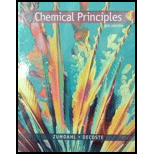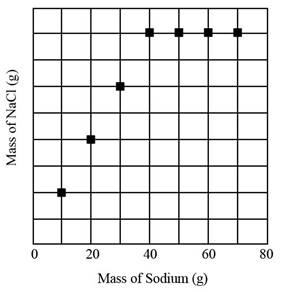
Concept explainers
(a)
Interpretation: The explanation of the shape of the given graph is to be stated.
Concept introduction:
(a)
Answer to Problem 104AE
The graph show increasing pattern as mass of
Explanation of Solution
The given graph is as follows.

Figure 1
The graph constitutes
The graph shows an increasing pattern at first as the mass of
Therefore, the graph show increasing pattern till fourth sample as mass of
(b)
Interpretation: The mass of
Concept introduction: Stoichiometric coefficients proportional to the respective chemical species can be correlated so as to compute their moles. The corresponding mass of these chemical species can then be worked out via their molar masses. The former concept is designated as stoichiometry. This concept can also be utilized to acquire limiting as well as excess reactants in given reaction.
(b)
Answer to Problem 104AE
The mass of
Explanation of Solution
The balanced reaction of
The given mass of
The number of moles of
The molar mass of
Substitute the values in equation (1).
The above reaction shows that
The mass of
The molar mass of
Substitute the values in equation (2).
Therefore, the mass of
(c)
Interpretation: The mass of
Concept introduction: Stoichiometric coefficients proportional to the respective chemical species can be correlated so as to compute their moles. The corresponding mass of these chemical species can then be worked out via their molar masses. The former concept is designated as stoichiometry. This concept can also be utilized to acquire limiting as well as excess reactants in given reaction.
(c)
Answer to Problem 104AE
The mass of
Explanation of Solution
The balanced reaction of
The above reaction shows that
The mass of
The graph shows that after fourth addition that is when
The mass of
Therefore, the mass of
(d)
Interpretation: The mass of
Concept introduction: Stoichiometric coefficients proportional to the respective chemical species can be correlated so as to compute their moles. The corresponding mass of these chemical species can then be worked out via their molar masses. The former concept is designated as stoichiometry. This concept can also be utilized to acquire limiting as well as excess reactants in given reaction.
(d)
Answer to Problem 104AE
The mass of
Explanation of Solution
The balanced reaction of
The given mass of
The molar mass of
Since, the maximum amount of
The number of moles of
The above reaction shows that
The molar mass of
Substitute the values in equation (2) to calculate the mass of
Therefore, the mass of
(e)
Interpretation: The left over reactants and their masses in parts b and d are to be calculated.
Concept introduction: Stoichiometric coefficients proportional to the respective chemical species can be correlated so as to compute their moles. The corresponding mass of these chemical species can then be worked out via their molar masses. The former concept is designated as stoichiometry. This concept can also be utilized to acquire limiting as well as excess reactants in given reaction.
(e)
Answer to Problem 104AE
The leftover reagent in part b is
Explanation of Solution
The balanced reaction of
The above reaction shows that
The mass of
The graph shows that
The given mass of
The mass of
The mass of
Substitute the values in equation (3).
The graph shows that in part d,
The mass of
Substitute the values in equation (4).
Therefore, the leftover reagent in part b is
Want to see more full solutions like this?
Chapter 3 Solutions
CHEM.PRINC.W/OWL2+REBATE+2 SUPPL.>IP<
- 62 Ammonium dinitramide (ADN), NH4N(NO2)2, was considered as a possible replacement for aluminium chloride as the oxidizer in the solid fuel booster rockets used to launch the space shuttle. When detonated by a spark, AND rapidly decomposes to produce a gaseous mixture of N2,O2, and H2O. (This is not a combustion reaction. The ADN is the only reactant.) The reaction releases a lot of heat, so the gases are initially formed at high temperature and pressure. The thrust of the rocket results mainly from the expansion of this gas mixture. Suppose a 2.3-kg sample of ADN is denoted and decomposes completely to give N2,O2, and H2O. If the resulting gas mixture expands until it reaches a temperature of 100°C and a pressure of 1.00 atm, what volume will it occupy? Is your answer consistent with the proposed use of ADN as a rocket fuel?arrow_forwardA crude oil burned in electrical generating plants contains about 1.2% sulfur by mass. When the oil burns, the sulfur forms sulfur dioxide gas: S(s) + O2(g) --> SO2(g) How many liters of SO2 (d= 2.60 g/L) are produced when 1.00 x 104 kg of oil burns at the same temperature as pressure?arrow_forwardA mixture of methane (CH₄) and butane (C₄H₁₀) at one atmosphere pressure and 25°C has a density of 1.639 g/L. Assuming ideal behavior, what is the mass in grams of carbon that are in 1 liter of the mixture?arrow_forward
- If 2.73 mol argon gas occupies a volume of 148 L at a particular temperature and pressure, what volume does 12.04 mol argon gas occupy under the same conditions?arrow_forwardA website promoting the use of alternative energy vehicles and hybrid technologies claims that, "A typical automobile in the USA uses about 4040 gallons of gasoline every month, producing about 750 lbs of carbon dioxide." To determine the truth of this statement, calculate how many pounds of carbon dioxide are produced when 40.0040.00 gallons of gasoline are subjected to complete combustion. Assume that the primary ingredient in gasoline is octane, C8H18(l),C8H18(l), which has a density of 0.703 g/mL.arrow_forwardThe great French chemist Antoine Lavoisier discovered the Law of Conservation of Mass in part by doing a famous experiment in 1775. In this experiment Lavoisier found that mercury(II) oxide, when heated, decomposed into liquid mercury and an invisible and previously unknown substance: oxygen gas. 1. Write a balanced chemical equation, including physical state symbols, for the decomposition of solid mercury(II) oxide (HgO) into liquid mercury and gaseous dioxygen. 2. Suppose 53.0mL of dioxygen gas are produced by this reaction, at a temperature of 50.0°C and pressure of exactly 1atm. Calculate the mass of mercury(II) oxide that must have reacted. Be sure your answer has the correct number of significant digits.arrow_forward
- Assuming that gasoline is 100% isooctane and that the density of isooctane is 0.792 g/mL, what mass of CO2 (in kilograms) is produced each year by the annual U.S. gasoline consumption of 4.6 X 1010 L?arrow_forwardA saline solution used in intravenous drips for patients who cannot take oral fluids contains 0.92 (w/v) NaCl in water. What volume of the saline solution must be administered to the patient in order to deliver 7.7 g of NaCl?arrow_forwardThe noble gas argon was discovered by Sir Walter Ramsay and John William Strutt in England in 1895. Through this discovery, they made highly accurate measurements of gas densities. Their experimentally determined densities are: Oxygen 1.42952 g/L Nitrogen 1.25718 g/L Air 1.29327 g/L 1) To determine the density of atmospheric nitrogen, Strutt removed the oxygen, water, carbon dioxide, and argon from air and then filled an evacuated glass tube with the remaining gas. He determined that a mass of 0.20389 g of nitrogen has a density of 1.25718 g/L under standard conditions of temperature and pressure. What is the volume of the glass tube in cm3?arrow_forward
- A mixture of hydrazine (N2H4) and hydrogen peroxide (H2O2) is used as a rocket fuel. These two substances react as shown by the equation: N2H4(l) + 2 H2O2(l) ⟶ N2(g) + 4 H2O(g) How many grams of hydrogen peroxide (H2O2) are needed to completely react with 50.0 grams of hydrazine (N2H4)? Note: the (l) and the (g) represent the PHYSICAL STATES in which the the substances are found. (l) means liquid and (g) means gas.arrow_forwardRefrigerators are usually kept at about 5゚C, when Room temperature is about 20゚C. If you were to take an empty 2 liter soda bottle at Room temperature and place it in the fridge, would you expect it to contract to 1/4 its original volume?arrow_forward[COMBUSTION] Per 1.00 L of C8H18, how much O2 is consumed in kg? ρ, C8H18: 0.703 kg/Larrow_forward
 Chemistry: Principles and ReactionsChemistryISBN:9781305079373Author:William L. Masterton, Cecile N. HurleyPublisher:Cengage Learning
Chemistry: Principles and ReactionsChemistryISBN:9781305079373Author:William L. Masterton, Cecile N. HurleyPublisher:Cengage Learning
 ChemistryChemistryISBN:9781305957404Author:Steven S. Zumdahl, Susan A. Zumdahl, Donald J. DeCostePublisher:Cengage Learning
ChemistryChemistryISBN:9781305957404Author:Steven S. Zumdahl, Susan A. Zumdahl, Donald J. DeCostePublisher:Cengage Learning Chemistry for Engineering StudentsChemistryISBN:9781337398909Author:Lawrence S. Brown, Tom HolmePublisher:Cengage Learning
Chemistry for Engineering StudentsChemistryISBN:9781337398909Author:Lawrence S. Brown, Tom HolmePublisher:Cengage Learning General Chemistry - Standalone book (MindTap Cour...ChemistryISBN:9781305580343Author:Steven D. Gammon, Ebbing, Darrell Ebbing, Steven D., Darrell; Gammon, Darrell Ebbing; Steven D. Gammon, Darrell D.; Gammon, Ebbing; Steven D. Gammon; DarrellPublisher:Cengage Learning
General Chemistry - Standalone book (MindTap Cour...ChemistryISBN:9781305580343Author:Steven D. Gammon, Ebbing, Darrell Ebbing, Steven D., Darrell; Gammon, Darrell Ebbing; Steven D. Gammon, Darrell D.; Gammon, Ebbing; Steven D. Gammon; DarrellPublisher:Cengage Learning Introductory Chemistry: A FoundationChemistryISBN:9781337399425Author:Steven S. Zumdahl, Donald J. DeCostePublisher:Cengage Learning
Introductory Chemistry: A FoundationChemistryISBN:9781337399425Author:Steven S. Zumdahl, Donald J. DeCostePublisher:Cengage Learning





